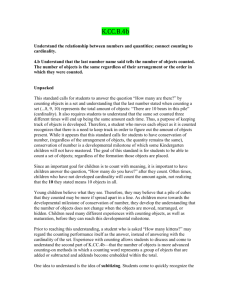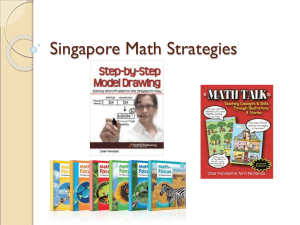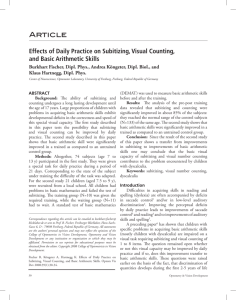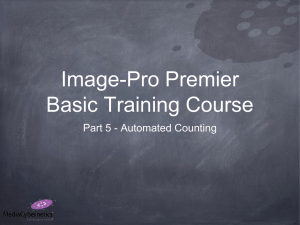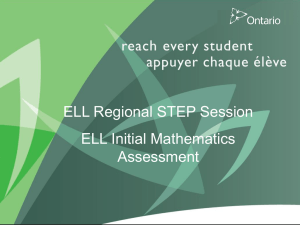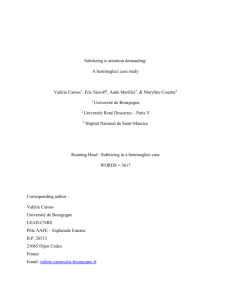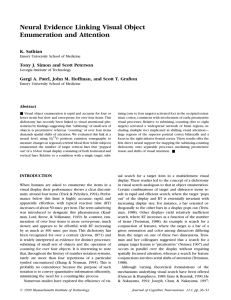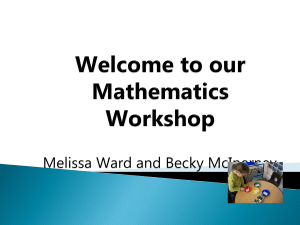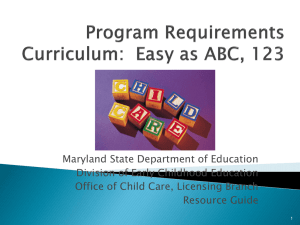Subitizing - Rossford Exempted Village Schools
advertisement
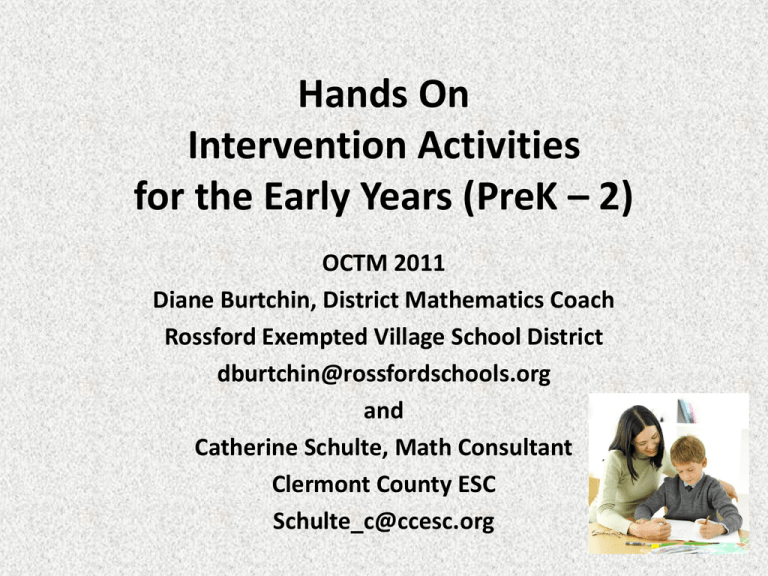
Hands On Intervention Activities for the Early Years (PreK – 2) OCTM 2011 Diane Burtchin, District Mathematics Coach Rossford Exempted Village School District dburtchin@rossfordschools.org and Catherine Schulte, Math Consultant Clermont County ESC Schulte_c@ccesc.org Why Number Sense? Students with strong Number Sense are: • Good at mental calculation and estimation • Fluid and flexible with numbers, the sense of what numbers mean • Able to look at the world and make comparisons • Not dependent upon Algorithms If Number Sense is weak, students struggle with these skills Developmental Mathematics Assessment (DMA) Ohio Educators • Dr. Mark Carter, Karen Boreman, and Dr. Debra Rucker www.developmentalmathgroup.com DMA • Individually administered assessment • Diagnostic (but can also be used as a screener in pK and K) • Preschool – Grade 2 Interventions Number Concepts Activity Book Early Number Concepts: Preschool • Matching: finding similar attribute(s) between two or more objects. • Sorting/Classification: arranging objects in a set by agreed upon attribute(s) • Comparing: observing similarities or differences • Ordering: using the same rule to arrange objects • Subitizing: instantly recognizing a small number of objects without counting Matching • What activities do you provide in your classroom that address the concept of matching? • Let’s consider the Stuart Murphy book - A Pair of Socks (read and follow up with activity) • Other Activities: – Memory, Candy Land, Uno Moo, Go Fish, Pop the Pig! Match It! Who Am I?, Uno, Twister – Mamas and Babies Cards or Figures – Animal Pairs Cards – Lids and bowls, paint card samples – Making outfits – Regular deck of cards – DMA kit manipulatives – Ellison Machine cut outs Classification (Sorting) • • • • Another Stuart Murphy book: 3 Little Firefighters Sorting Cards Activity Sorting Plastic Animals Sorting a Variety of Objects (paper clips, colored chips, colored animals, DMA manipulatives, candy, etc.) • Try asking students to sort by color • Then try to sort a different way Comparing • Activity Ideas: • Pig, Pigger, Piggest by Rick Walton • Using piles of anything (DMA manipulatives, coins, paper clips, etc) have the students decide on the following: greatest/least; smallest/biggest or largest, etc. (emphasis on vocabulary) • Try three piles as well with the following: big/bigger/biggest; short/shorter/shortest; long, longer, longest, etc. • Set of 3 Nesting Dolls for the same activity Ordering • Activities: – Ordering of objects: tupperware, measuring cups and/or spoons, nesting cups, F.P. colored rings, measuring worms, bear counters, plastic animals, DMA manipulatives, pom poms, etc. – Can order by size, length, height What is Subitizing? • What is subitizing? • Is “instantly seeing how many” Clements, 1999 • “Is a fundamental skill in the development of students’ understanding of number” Baroody, 1987 • Many researchers agree that counting focuses on the unit and measurement focuses on the whole. Subitizing focuses on BOTH. Two Types of Subitizing • Perceptual – Recognizing a number without using any other mathematical processes • Children “see 3” without using any learned mathematical knowledge • Conceptual – Advanced organizational plan for mathematics • Children who see an 8 domino and “just know” the total number • They are seeing each side of the domino as composed of four individual dots and as “one four”, so the 8 would be two groups of 4 which is “one eight” Subitizing • Activities: – Read 10 Black Dots by Donald Crews – Paper Plates Activity – Index cards activity – Finger, quantity, symbol matching – Dice and dominoes – Ready, Set, Count! game – 5 and 10 Frames Advanced Number Concepts: Kindergarten through Grade 2 • Word - Students need to know the number words appropriate for their age level. They need to use the words in the appropriate sequence, both counting forward and counting back. • Quantity - Students should learn to demonstrate an understanding of quantity through appropriate object counting. • Symbol - All school-aged students need to know how to identify and write age level appropriate numeral symbols. • Relationships: – – – – – 1 or 2 more 1 or 2 less Visual patterns Comparisons Part/part/ whole & place and value Developing Early Number Concepts Word Relationships Quantity Symbol Word Activities Counting • Counting books – forward/back • Counting Activities • Counting Centers • Number lines, 0-99 chart, 1-30 chart, etc • Number before/after Quantity Activities Object Counting • • • • • • Number Concept Dot Activities Counting with Other Objects Counting Different Arrangements Different Starting Points Hand Me Board games such as Chutes & Ladders, Hi Ho Cherry O, The Ladybug Game, Five Little Monkeys and so forth • Be sure to emphasize the concept of cardinality! – A student has cardinality if he/she can tell you how many are in a set without recounting the entire set. – You check on this by asking after each counting activity “How many are in this set?” Symbol Activities Identifying/Writing • Identifying Symbols – Match game – Cover/Uncover • Writing Numerals – Tracing, sandpaper, clay, pipe cleaners – Guess My Number – Telephone Game Relationships • • • • • One and two more One and two less Visual patterns Comparisons Part-Part-Whole, Place and Value • • • • • • Dot Patterns Dominoes 5 frames 10 frames Part-whole mats Slide cards Center Time! • On each table there is a tub with a number of activities for the related topic. • This is not a comprehensive list! • As you review the activities, you are encouraged to record your thinking on the sheet provided. (Wow-Wonder-Steal) • We will pass the tubs so that each table can review as many as possible in the time remaining. Questions/Comments • What is your thinking? • What questions can we answer for you? Diane Burtchin dburtchin@rossfordschools.org Catherine Schulte Schulte_c@ccesc.org Example of Questions on the DMA Match each question from the DMA to one of the Early Number Concepts: Sort these into piles. How did you sort them? Find a strip that matches this one. Find one that is longer than this one. I am going to flash my fingers. Show me with your fingers what you saw me do. Put these in order from shortest to longest. Example of Interventions Which skill is this intervention going to address? Play “I Spy” games with the child using ‘smaller than’, ‘larger than’, or ‘heavier than’ or ‘lighter than’ http://www.scholastic.com/ispy/ Example of Questions on the DMA Match each question from the DMA to one of the Advanced Number Concepts: Count back from 5. Count the Unit Dots. Point to each dot as you count. Write the number 6. Tell me the numerals I show you. This is 2. What is one more? This is 5. What is one less than five? I have made 5 using 4 red and 1 blue. Make 5 another way using both colors. Example of Interventions Which skill is this intervention going to address? Use counting nursery rhymes. Model how to tag and move objects into a counted set. Provide tracing activities (in flour, sand, shaving cream) for reinforcement of numerals 0-9 Model and support how to recognize the quantity without counting What Have We Learned in Our District Through the DMA’s? • Completed over 200 DMA’s in REVS • All Kindergarteners are now screened with the DMA in our district • Some trends: – Issues with cardinality at lower levels – More/less showed weaknesses (sometimes due to language) – Two biggest areas of concern: Subitizing and Part/Part/Whole Matching • Understanding of 1-to-1 correspondence • Basis for our number system • Prerequisite skill for conservation – Different – easier for students to establish – Same – harder for students to determine • Move to items that have the same amount • Include remainders or extras as students will encounter in the next grade levels Classification (Sorting) • Looking at characteristics of different items and finding characteristics that are the same • Start with one attribute (usually color) • When looking at two or more attributes, looking at collections Comparing Relationship of More Less Same These relationships are basic to the concept of number Remember that these children are not yet counting so the comparisons need to be obvious Seriation (Ordering) • Foundational to our number system • Putting items in order is prerequisite to putting numbers in order • Why? – So students put items in an order so the items are counted once and only once • Seriation – Ordering objects by size, length, or height – Making decisions So How Do We Help Students Develop The Ability To Subitize? • Start young children out with activities related to perceptual subitizing to build initial ideas of cardinality (fingers, rhythms, spatial-auditory) • Move into more complex ideas that contain part/part/whole (like dominoes and colored dots) • Be certain to vary the patterns (multiple representations of numbers) • Paper Plate Activity Factors Influencing Subitizing • The spatial arrangement influences the level of difficulty • Younger children (ages 2-4)- able to do linear arrangements easier than others • Older children (age 5 and up)- exposure for the types of arrangements should progress from rectangular to linear to circular to scrambled • Therefore, we should start exposing them to multiple representations early to build this ability to subitize Preventing the Gaps • Activities for Pre-K & K to provide intentional instruction • Focus: Number Concepts Object Counting • • • • • • Number Concept Dot Activities Counting with Other Objects Counting Different Arrangements Different Starting Points Hand Me Board games such as Chutes & Ladders, Hi Ho Cherry O, The Ladybug Game, Five Little Monkeys and so forth • Be sure to emphasize the concept of cardinality! – A student has cardinality if he/she can tell you how many are in a set without recounting the entire set. – You check on this by asking after each counting activity “How many are in this set?” Writing Symbols-Symbol Motor Plan Down Over Part Way Round Diagonal Circle All digits can be made with one or a combination of these 5 strokes! Symbol Motor Plan Activities • Guess My Number (p.43) • Formation using sand, play dough, shaving cream, etc. Symbol to Quantity • Cover – Up – Roll die/dice and cover the number/s that appear – First person to “cover – up” is the winner • Uncover – Cover all numbers, roll the dice, uncover the numbers – First person to “uncover” is the winner Subitizing Order First: Use your subitizing plates with the typical dot arrangements of numbers 1 to 5 Subitizing Order Then: Add different arrangements to the activity! Subitizing – Conceptual Remember – Different arrangements lead to different decompositions of that number Number Bonds - Relationships Move towards number bonds using numbers up to 5. 5 3 2 5 1 ? Subitizing Order • Finally: Introduce to 5-Frames Relationships – Visual Patterns 5-Frames • Subitizing – brain can only “see” 6; after 6 the brain moves to part-part-whole • Need your 5-frame mat and counters • Show us a 3 on your 5-frame • What did you do? • Why? • How far from 5 is 3? • How many more counters would be needed to make 5? Relationships – Visual Patterns 10-Frames • Pre-K and K: – Research says that place value does not occur during Pre-K, K and 1st grade – Rather the focus is on “10 and some more” – Place value begins in the 20’s Relationships - Comparisons • • • • Pg. 67 Compare Greater or Fewer Make the Same Make Fewer Relationships – Part-Part-Whole Pg. 79 • Two Parts Behind My Back Combining Word, Quantity and Symbol • Always make your number lines interactive – adding on, removing symbols, etc. (Number line with the word, symbol, and quantity) • Brainstorm other ideas for connecting these ideas and record them on the sheet provided. Each group will add to the list. Aha’s! • What was a big aha for you? • What did you really like? • What is still a stumbling block?
